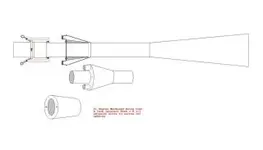Timberdoodle
Sr. Member
- Joined
- Oct 17, 2012
- Messages
- 316
- Reaction score
- 243
- Golden Thread
- 0
- Location
- Kingfield, Maine
- Primary Interest:
- All Treasure Hunting
That's basically it in a nutshell. I find that in the reduction taper at the rear it is better to have a more sweeping flare than a quick 45 type taper and the overall length can be shorter considerably by locating the inlet down at the end. No need for any manifold space in front of the inlet. Your going to want at least 1-2ft of hydraulic load length after the jet and this can be fulfilled by hose or the use of a flare design that does not increase for this distance(see a proline flare)




